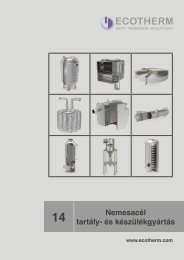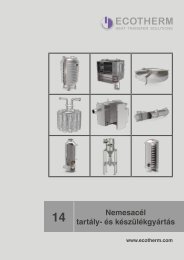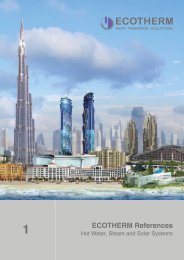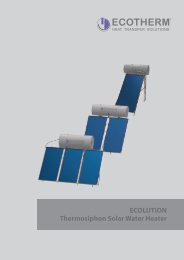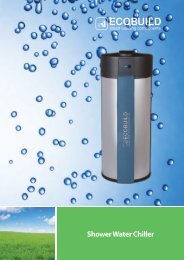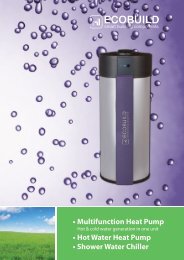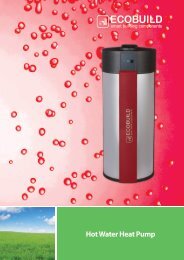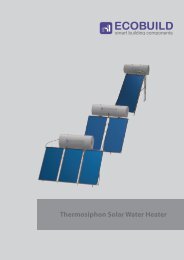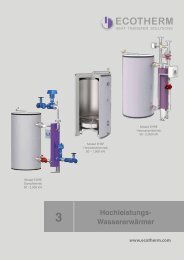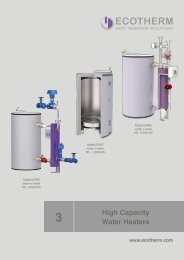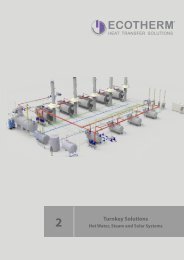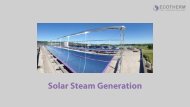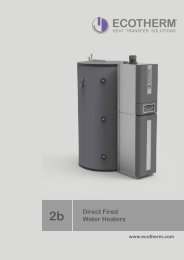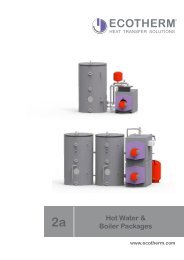BRO Steam Solutions
Create successful ePaper yourself
Turn your PDF publications into a flip-book with our unique Google optimized e-Paper software.
Products: Feed Water Tanks<br />
Feed Water Tanks & Deaerators<br />
Description<br />
The feedwater deaerating plant, consisting of the feedwater<br />
tank and the deaerator, removes dissolved gases such as<br />
oxygen, carbon dioxide and other non-condensable gases<br />
from boiler feedwater and makeup water.<br />
For the operation of steam boilers with high thermal load<br />
on the heating surfaces boiler feedwater must be treated<br />
and conditioned.<br />
The boiler feedwater must be free of hardening constituents<br />
in order to prevent the formation of scale on the boiler heating<br />
surfaces. The presence of dissolved oxygen and carbon<br />
dioxide causes severe corrosion of metal boiler parts. The<br />
feedwater deaerating plant is custom designed for each<br />
application and meets essential thermo dynamic requirements<br />
to achieve optimal performance.<br />
Technical details on pages 48 - 49.<br />
Benefits:<br />
• Sizes from 200 to 20,000 liters<br />
• Pressure resistant<br />
• Material: mild steel, stainless steel<br />
AISI 304 / 316 / Duplex SS<br />
• Completely preassembled unit<br />
• All valves, pumps, instruments are<br />
custom-designed according to<br />
steam boiler system<br />
Function<br />
The make-up water and return condensate enters the<br />
deaerator that is fitted with a series of tray compartments<br />
to provide maximum spilling. Heating steam is fed into the<br />
deaerator from below. The make-up water and return condensate<br />
are deaerated and flow directly into the feedwater<br />
tank, which is flanged to the deaerator. The feedwater tank,<br />
which is heated by means of a steam injector, heats up the<br />
feedwater to 105°C.<br />
The solubility of gases in water can be described by Henry<br />
Dalton‘s law of absorption which states that gas solubility in<br />
a solution decreases as the gas partial pressure above the<br />
solution decreases. This means that the gas solubility in a<br />
solution decreases as the temperature of the solution rises<br />
and approaches saturation temperature.<br />
The make-up water and return condensate is distributed<br />
over the series of trays and comes in direct contact with<br />
the heating steam. This process reduces the solubility of<br />
oxygen and carbon dioxide and removes these gases from<br />
the feedwater. The released gases work their way to the<br />
top of the vessel where they are vented from the deaerator<br />
via the vent line.<br />
A temperature-controlled heating system for warming up a<br />
cold feedwater tank is provided.<br />
Due to the fact that the feedwater temperature is above<br />
100°C enough net positive suction head (NPSH) is required<br />
to ensure that the weight of the column of water in the line<br />
exerts enough pressure at the feed water pump suction to<br />
prevent the formation of steam bubbles and therefore the<br />
water from cavitating. Therefore a support construction is<br />
required.<br />
12 ECOTHERM <strong>Steam</strong> <strong>Solutions</strong>



